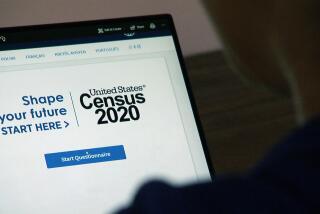POPULATION : U.S. Studies Employing Fewer Census Takers, More Estimates
- Share via
WASHINGTON — Since 1787, when the Constitution called for a count of everybody every 10 years, census takers have hit the streets in search of America itself--specifically, those citizens who didn’t return census forms.
But if the government’s Panel on Census Requirements gets its way, many of these temporary census takers will have to look elsewhere for work during the next head count, slated for 2000. The panel says the Census Bureau can get a more accurate reading by using statistical estimates than by sending census takers out in search of the uncounted.
“You can deceive yourself into thinking you’ve done a better job when you really haven’t,” said James Trussell, professor of economics and public affairs at Princeton University and a member of the commission. “We’ve got to change the way we look at conducting a census.”
In the current process, surveys are mailed out, then census takers on the streets try to count those who did not respond.
The problem is that despite repeat visits, many people aren’t recorded. Counting people in urban areas is not as easy as knocking on doors in suburban single-family neighborhoods. Cities are packed with people living on the margin--the homeless, addicts and squatters.
As the panel would have it, the new census would first mail out the survey to all Americans and make a “good-faith attempt” to locate those people using on-foot census takers.
After that, the Census Bureau would choose a handful of target zones around the country and saturate them with census takers. The idea would be to get a nearly perfect count in those areas, and then use those findings to construct a statistical model for the nation.
Stephen E. Fienberg, professor of statistics and social science at Carnegie Mellon University, said the panel’s method fuses old mathematical techniques with the latest statistical advances to account for those regularly missed by the head count.
The report also calls for the Census Bureau to create more reader-friendly surveys and to expand efforts to publicize the mandatory nature of the census. Additionally, the report acknowledged that the issue of identifying one’s race on the census may need to be more closely examined, now that more people of mixed races are born.
Martha Farnsworth Riche, the director of the Census Bureau, said that the statistical method would cut costs and improve accuracy. A test census is planned for 1995 to experiment with methods prescribed by the panel, she said.
Accuracy isn’t the only advantage, commission members say. The report says that if statistical estimation had been used in the 1990 census, the government could have saved up to $400 million on the total bill of $2.6 billion. The savings would be even higher in 2000.
Statistical estimation would answer a longstanding call for more accurate data in cities heavily populated by minorities . In 1990, the census came under fire for undercounting blacks, Latinos and other minorities. The census counted 248.7 million Americans, but statistical estimates calculate that 3 million people were missed.
Changing course to use estimates would have political implications: The census determines the boundary lines of congressional, state and local districts. It also determines the number of congressional districts in each state.
The new procedure would likely turn up many more minorities in cities, which have been known to usually vote Democratic.
Wade Henderson, director of the Washington chapter of the National Assn. for the Advancement of Colored People, said the undercount is a serious issue for the 2000 census.
“For the NAACP, the greatest concern is the accuracy of the census,” Henderson said. “The undercount of African Americans in 1990 was deplorable. All steps must be taken to keep it from happening again.”
Charles L. Schultze, chairman of the panel, will appear today with other panelists before a House subcommittee to discuss the proposal. Any changes in the census’ method of operation must be approved by the Office of Management and Budget, the Census Bureau and two congressional panels.
More to Read
Sign up for Essential California
The most important California stories and recommendations in your inbox every morning.
You may occasionally receive promotional content from the Los Angeles Times.













